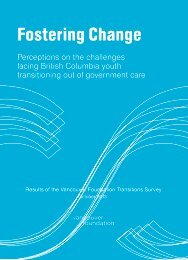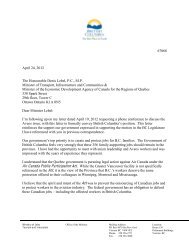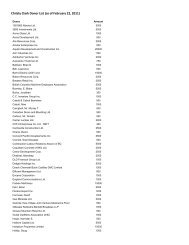from the ground up - The Tyee
from the ground up - The Tyee
from the ground up - The Tyee
Create successful ePaper yourself
Turn your PDF publications into a flip-book with our unique Google optimized e-Paper software.
Since <strong>the</strong> 1970s, many green technology promotersinstalled expensive solar photovoltaic arrays orgeo<strong>the</strong>rmal heat pumps on existing buildings as a wayof demonstrating <strong>the</strong>ir products. In so doing, <strong>the</strong>ycreated facilities that generate carbon-free power,<strong>the</strong>n squander that energy in drafty and poorly insulatedbuildings. Such kluge-like constructions are <strong>the</strong>anti<strong>the</strong>sis of green design, but it’s understandable thatpassersby could confuse <strong>the</strong>m for green buildings.Likewise, <strong>the</strong> prototypical Vancouver condo building-- towers of (poorly insulated) glass separated by(heat radiating) concrete balconies -- provides about atenth of <strong>the</strong> insulation value that a wood-frame homedoes. Yet, through <strong>the</strong> addition of a few energy efficientappliances, unscr<strong>up</strong>ulous (or merely ignorant)marketers have succeeded in labeling condo towers as“green” buildings.<strong>The</strong> truth is that mainstream green building certificationsystems such as LEED, Built Green Canada, andGreen Globes all reward strategies that lower energydemand, while next-generation standards such as Passivhausand Living Buildings are whittling buildingenergy use very close to zero.Research has confirmed that certified green buildingssave energy and money. A study by <strong>the</strong> New BuildingsInstitute found energy use in green buildings tobe 24 per cent lower than in conventional buildings.And a survey by <strong>the</strong> US General Services Administrationfound that <strong>the</strong> first dozen LEED buildings inits portfolio consumed 26 per cent less energy andproduced 33 per cent lower carbon dioxide emissionsthan comparable government-owned buildings.Myth #4: Green buildings are less comfortable.This idea may be rooted in a Victorian perception of“comfort,” which cherishes plush drapes and thickcarpets and lavish wallcoverings.<strong>The</strong> Victorian approach to interior decorating madegood sense in an era when homes were exceedinglydrafty and everything was made <strong>from</strong> natural materials.But buildings changed. By <strong>the</strong> 1970s, curtain wallshad led to office buildings with controlled ventilation.And by <strong>the</strong> 1990s, better quality windows and doorshad made many homes relatively air-tight.So did furnishings. By <strong>the</strong> late 20th century, <strong>the</strong> useof toxic chemicals had become commonplace in <strong>the</strong>manufacture of paint, carpet and furniture. Many ofthose chemicals, such as formaldehyde and vinyl,continue off-gassing for years. For a time, consumerswere persuaded that <strong>the</strong> resulting “new car smell”was a benefit. But as buildings became tighter, peoplestarted to get sick.Studies by <strong>the</strong> U.S. Environmental Protection Agencyfound that, on average, Americans spend 90 per centof <strong>the</strong>ir time indoors, where <strong>the</strong>y are exposed to concentrationsof chemical pollutants that are 100 timesgreater than outdoors.Green design aims to improve indoor air quality byeliminating toxic building materials. Many first-generationgreen buildings eliminated carpet and drapesaltoge<strong>the</strong>r. <strong>The</strong>se were replaced with nontoxic -- buthard -- surfaces such as wood or concrete. Somepeople found <strong>the</strong> hard surfaces within <strong>the</strong>se firstgenerationgreen structures to be cold, uninviting andacoustically annoying.In <strong>the</strong> past decade, <strong>the</strong> s<strong>up</strong>ply of non-toxic finishingsand furnishings has caught <strong>up</strong> with <strong>the</strong> demands ofair-tight green buildings. Nontoxic paints and carpetsare now commonplace. And <strong>the</strong> choice of interiorfinishings is once again a matter of taste ra<strong>the</strong>r thantoxicity.Myth #5: Green building is a fad.As was <strong>the</strong> case with <strong>the</strong> previous myths, past is prologue.Alternative building exploded in <strong>the</strong> 1970s. Backyardinventors pioneered ideas about solar design and naturalmaterial selection that have evolved into today’sgreen building standards. But an awful lot of thosedo-it-yourself homes were, in a word, awful. A fewbuildings survived, but <strong>the</strong> movement did not.Having watched that fad come and go, constructionindustry veterans should be forgiven for believing thatthis green building boom will do <strong>the</strong> same. Many arequick to point out that few of those early alternative20








